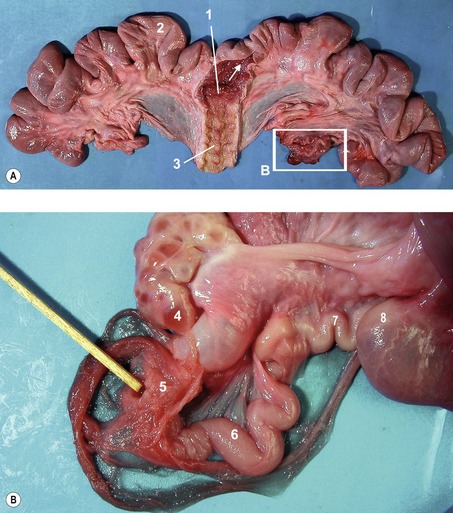CHAPTER 3 Comparative reproduction
This chapter provides an introduction to the regulatory systems involved in reproduction, with a particular focus on the female and on the hormones of pregnancy that have such a direct bearing on embryology. For further details on more general reproductive physiology, especially in the male, readers are referred to textbooks listed at the end of the chapter.
PUBERTY AND THE OESTROUS CYCLE
The female reproductive system consists of the paired ovaries, in which the oocytes develop, and the tubular genital tract comprising the oviducts, uterus, vagina, and vestibulum (Fig. 3-1). The oviduct is divided into a wide funnel-shaped portion, the infundibulum, that receives the oocyte(s) at ovulation, a wide tubular portion, the ampulla, and a longer thin portion, the isthmus, connecting to the uterine horn. Fertilization is thought to occur at the transition between the ampulla and isthmus. The ovary, except in the mare, is found in the ovarian bursa – a cavity formed mainly by the mesosalpinx. In domestic animals the uterus is bicornuate, comprising two uterine horns, the uterine body, and the uterine cervix. The uterine body is short in most species but relatively long in the mare. The cervix presents an internal orifice (or os) to the uterine body and an external orifice (os) to the vagina. The external orifice forms a prominent portio vaginalis in the ruminants and the mare. The cervical canal is bordered with longitudinal folds. Additional circular folds are found in ruminants and protrusions, the pulvini cervicales, lock into each other in the cervix of the sow. The opening of the urethra marks the transition between the vagina and the vestibulum, which is demarcated externally by the vulva. In the adult cow and mare, the ovaries and the uterus can easily be manipulated by rectal palpation, a method widely used for assessment of the reproductive status of the ovaries, particularly in cattle. In the mare, and to a lesser extent in other species, ovarian status and initiation of pregnancy can be readily assessed using transrectal ultrasound scanning.
Before puberty, the initial development of the female gametes, the oocytes, enclosed in their ovarian follicles, is regulated more or less autonomously. However, as will be explained in Chapter 4, such pre-pubertal oocytes never reach a stage of development at which they are ready for fertilization. After the onset of puberty, however, signals provided by certain regions in the brain, including the pineal gland, hypothalamus and the pituitary gland, allow for production of fertilizable oocytes. From the anterior pituitary gland, the gonadotropins (i.e. hormones stimulating cells within the gonads) FSH (follicle-stimulating hormone) and LH (luteinizing hormone) are released. This release is controlled by GnRHs (gonadotropin-releasing hormones) that are secreted from the hypothalamus and conveyed to the anterior pituitary gland through the hypothalamo-hypophyseal portal blood circulation. Secretion of GnRHs, and thus of FSH and LH, is influenced by visual, olfactory, auditory and tactile stimuli from the environment and also by homeostatic feedback systems within the animal. It is not until puberty that the central nervous system has matured sufficiently to allow the complex integration of all these inputs.
The onset of puberty precedes the development of physical maturity. Therefore, although the pubertal female is fertile (sexually mature and able to reproduce), her fecundity has not yet reached its maximum. Factors influencing the onset of puberty include age, body weight, breed, nutrition, disease and, in some species, season of the year and proximity of a male. The ages at which the common domestic species reach puberty are listed in Table 3-1.
Table 3-1: Age at puberty in common domestic animal species
| Species | Age at puberty |
|---|---|
| Cattle | 8–18 months |
| Horse | 10–24 months |
| Swine | 6–8 months |
| Sheep | 6–15 months |
| Goat | 4–8 months |
| Dog | 6–20 months |
| Cat | 5–12 months |
FSH released from the pituitary gland reaches the ovary by the systemic circulation. In the ovary, it stimulates a pool of growing follicles to develop further (see Chapter 4). Oestrogens, which are produced in the granulosa and theca cells lining the follicle and surrounding the oocyte, exert a positive feedback on the hypothalamic GnRH secretion. Another principal effect of the oestrogens is to induce oestrous symptoms, and so puberty is often signalled by the occurrence of the first period of oestrus or heat (sexual receptivity). After puberty, the animal enters a phase of life characterized by repeated oestrous cycles. The oestrous cycle is subdivided into prooestrus, oestrus, metoestrus, and dioestrus (Tables 3-2, 3-3).
Table 3-2: Characteristics of the different phases of the oestrous cycle and anoestrus.
| Phase1 | Characteristics |
|---|---|
| Prooestrus | The phase immediately preceding oestrus. The main hormones being produced in the ovary are oestrogens. |
| Oestrus | The period (under natural conditions) of acceptance of the male. Ovulation occurs during this phase in all domestic species, with the exception of the cow where it occurs shortly afterwards. The main hormones being produced in the ovary, in response to FSH and LH, are oestrogens. |
| Metoestrus | The phase succeeding oestrus when the male is no longer accepted. Period of corpus luteum formation. The main hormone being produced in the ovary is progesterone. |
| Dioestrus | The period of the mature, functional corpus luteum. The main hormone being produced in the ovary is progesterone. |
| Anoestrus | The prolonged phase of sexual rest interrupting oestrous cyclicity in some species. The reproductive system is mainly quiescent. |
1 The phases of prooestrus and oestrus may collectively be referred to as the follicular phase and the phases of metoestrus and dioestrus may be referred to as the luteal phase.
< div class='tao-gold-member'>
Stay updated, free articles. Join our Telegram channel

Full access? Get Clinical Tree




